Spectrum Sensing Techniques and Cognitive Radio
Added on 2023-03-31
27 Pages5112 Words123 Views
SPECTRUM SENSING TECHNIQUES AND COGNITIVE RADIO
STUDENT NAME
STUDENT REGISTRATION NUMBER
DATE OF SUBMISSION
1 | P a g e
STUDENT NAME
STUDENT REGISTRATION NUMBER
DATE OF SUBMISSION
1 | P a g e
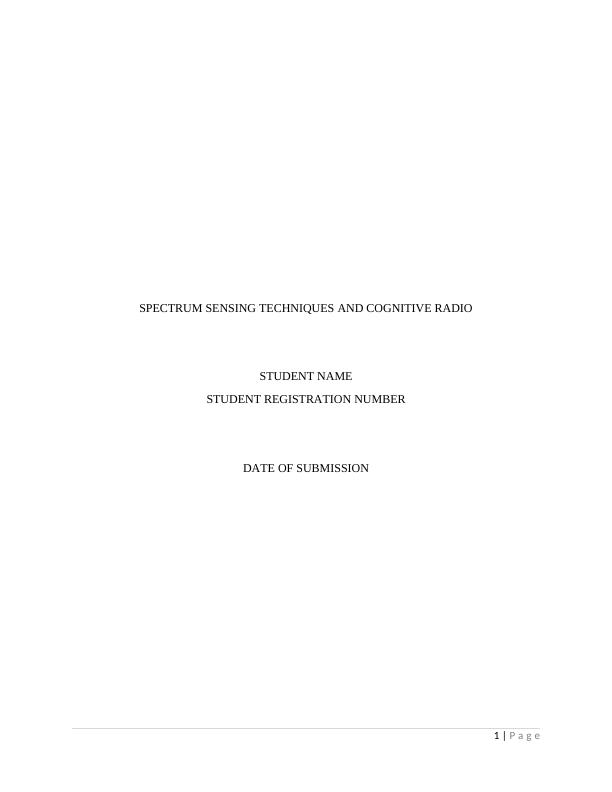
ABSTRACT
The mobile communication networks in the modern age are adopting a level of intelligence to
ensure that they sense and automatically adapt to the environment accordingly. The mobile
multimedia networks are faced with several challenges like the scarce resource allocation of the
frequency spectrum and the interference of channels during communication. There is a lot of
wastage when a given section of the frequency spectrum is allocated yet unused. Most of the
cognitive networks are applied to enable dynamic spectrum access, co-existence of different
wireless networks, and interference management. The cognitive radio paradigm is set to drive the
next generation of standards and principles governing the mobile communication and cellular
networks. The cognitive radio technology ensures that the communication systems have flexible
development and there is the deployment of the highly adaptive radios where systems are built
upon the software defined radio technology.
The cognitive radio technology opens several frontiers that can be explored to develop better and
more efficient wireless communication systems for wireless and mobile computing. The systems
end up forming the cognitive radio networks in the cellular mobile communication networks by
extending the radio link features and attributes to a given network layer function. The system
classifies the CRN architecture into a number of unidirectional links and structures. This paper
seeks to carry out an analysis on the MATLAB software for the cognitive network and the
performance analysis of the spectrum-reuse. Common networks introduce issues for the protocol
design, power efficiency, spectrum management and detection, for the emotional awareness and
improved algorithm design. The radio resource allocation policies and economic considerations
are posed by the inherent transmission misappropriations on the wireless links and mobility of
the mobile network end users.
2 | P a g e
The mobile communication networks in the modern age are adopting a level of intelligence to
ensure that they sense and automatically adapt to the environment accordingly. The mobile
multimedia networks are faced with several challenges like the scarce resource allocation of the
frequency spectrum and the interference of channels during communication. There is a lot of
wastage when a given section of the frequency spectrum is allocated yet unused. Most of the
cognitive networks are applied to enable dynamic spectrum access, co-existence of different
wireless networks, and interference management. The cognitive radio paradigm is set to drive the
next generation of standards and principles governing the mobile communication and cellular
networks. The cognitive radio technology ensures that the communication systems have flexible
development and there is the deployment of the highly adaptive radios where systems are built
upon the software defined radio technology.
The cognitive radio technology opens several frontiers that can be explored to develop better and
more efficient wireless communication systems for wireless and mobile computing. The systems
end up forming the cognitive radio networks in the cellular mobile communication networks by
extending the radio link features and attributes to a given network layer function. The system
classifies the CRN architecture into a number of unidirectional links and structures. This paper
seeks to carry out an analysis on the MATLAB software for the cognitive network and the
performance analysis of the spectrum-reuse. Common networks introduce issues for the protocol
design, power efficiency, spectrum management and detection, for the emotional awareness and
improved algorithm design. The radio resource allocation policies and economic considerations
are posed by the inherent transmission misappropriations on the wireless links and mobility of
the mobile network end users.
2 | P a g e
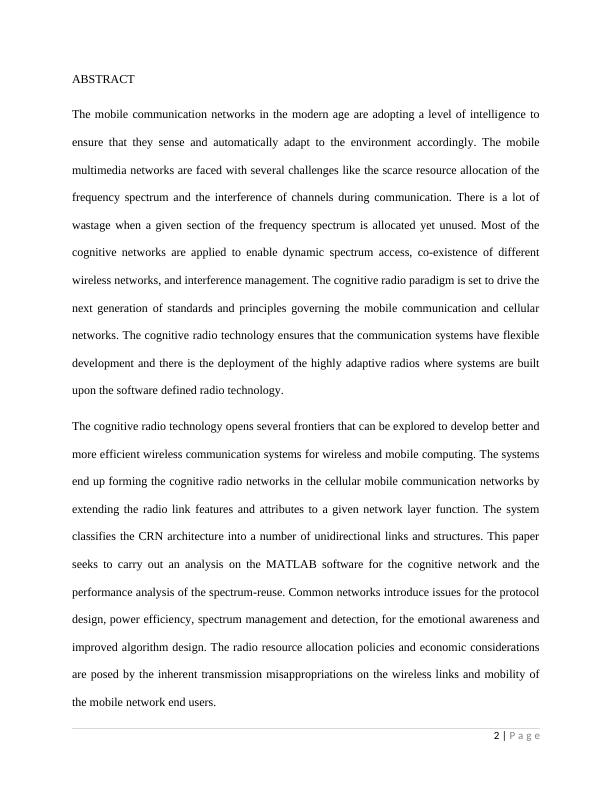
TABLE OF CONTENTS
INTRODUCTION.....................................................................................................................................4
LITERATURE REVIEW.........................................................................................................................6
Cognitive radio networks.........................................................................................................................6
Digital modulation.................................................................................................................................11
Spectrum sensing...................................................................................................................................12
Signal detection & Link budgets and cognitive radio network design...................................................18
Agile transmission techniques in cognitive radio networks...................................................................20
SYSTEM MODELLING & MATLAB IMPLEMENTATION............................................................20
CONCLUSION........................................................................................................................................21
REFERENCES........................................................................................................................................21
3 | P a g e
INTRODUCTION.....................................................................................................................................4
LITERATURE REVIEW.........................................................................................................................6
Cognitive radio networks.........................................................................................................................6
Digital modulation.................................................................................................................................11
Spectrum sensing...................................................................................................................................12
Signal detection & Link budgets and cognitive radio network design...................................................18
Agile transmission techniques in cognitive radio networks...................................................................20
SYSTEM MODELLING & MATLAB IMPLEMENTATION............................................................20
CONCLUSION........................................................................................................................................21
REFERENCES........................................................................................................................................21
3 | P a g e
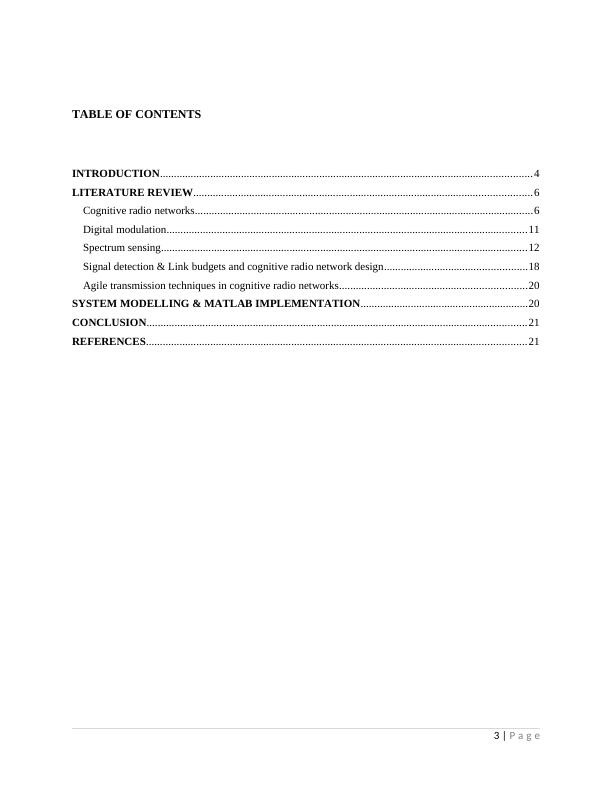
INTRODUCTION
There is a growing need for the wireless applications and services and as a result the spectrum
resources are needed to meet this demand. The spectrum is allotted to services where the service
provider acquires a frequency band or block from the telecommunication regulatory body in a
given nation. All the services provided require some frequency block which is expected to
increase rapidly and it is able to move towards a fully wireless system where the spectrum is
enhanced. It is very difficult to find a frequency block years later as the primary spectrum is
already assigned to several existing services. The regulatory bodies do not allow the unlicensed
users to access the licensed spectrum. These unlicensed users are required to use a highly
complex, interference-prone frequency band with other unlicensed users. There is indeed a huge
spectrum scarcity problem for the primary frequency spectrum band. A swift scan of the
frequency bands allocated for services in urban settings reveals many unoccupied frequency
bands in the spectrum while those occupied may only be partially occupied. The remaining parts
are heavily used. The radio spectrum, for instance, is quite a limited resource. The resource is
governed by telecommunication bodies and national communication regulatory bodies such as
the federal communication commission in the United States of America.
Cognitive networks are used in the development of the experimental protocol stack to be
implemented in system networks, for instance, cognitive radios. The networks are developed to
have scalable auto-configuration and network management. The dynamic network layer seeks to
support the functionality of the system such that there is IP, group messaging, and rich queries
for the system. The network build on the foundation of the cognitive radio using the GNU radio,
KU agile radio, and the Rutgers radio which has a protocol stack built upon it. The network layer
has an overlay with structured and unstructured for the P2P and the DHT. The services are used
4 | P a g e
There is a growing need for the wireless applications and services and as a result the spectrum
resources are needed to meet this demand. The spectrum is allotted to services where the service
provider acquires a frequency band or block from the telecommunication regulatory body in a
given nation. All the services provided require some frequency block which is expected to
increase rapidly and it is able to move towards a fully wireless system where the spectrum is
enhanced. It is very difficult to find a frequency block years later as the primary spectrum is
already assigned to several existing services. The regulatory bodies do not allow the unlicensed
users to access the licensed spectrum. These unlicensed users are required to use a highly
complex, interference-prone frequency band with other unlicensed users. There is indeed a huge
spectrum scarcity problem for the primary frequency spectrum band. A swift scan of the
frequency bands allocated for services in urban settings reveals many unoccupied frequency
bands in the spectrum while those occupied may only be partially occupied. The remaining parts
are heavily used. The radio spectrum, for instance, is quite a limited resource. The resource is
governed by telecommunication bodies and national communication regulatory bodies such as
the federal communication commission in the United States of America.
Cognitive networks are used in the development of the experimental protocol stack to be
implemented in system networks, for instance, cognitive radios. The networks are developed to
have scalable auto-configuration and network management. The dynamic network layer seeks to
support the functionality of the system such that there is IP, group messaging, and rich queries
for the system. The network build on the foundation of the cognitive radio using the GNU radio,
KU agile radio, and the Rutgers radio which has a protocol stack built upon it. The network layer
has an overlay with structured and unstructured for the P2P and the DHT. The services are used
4 | P a g e
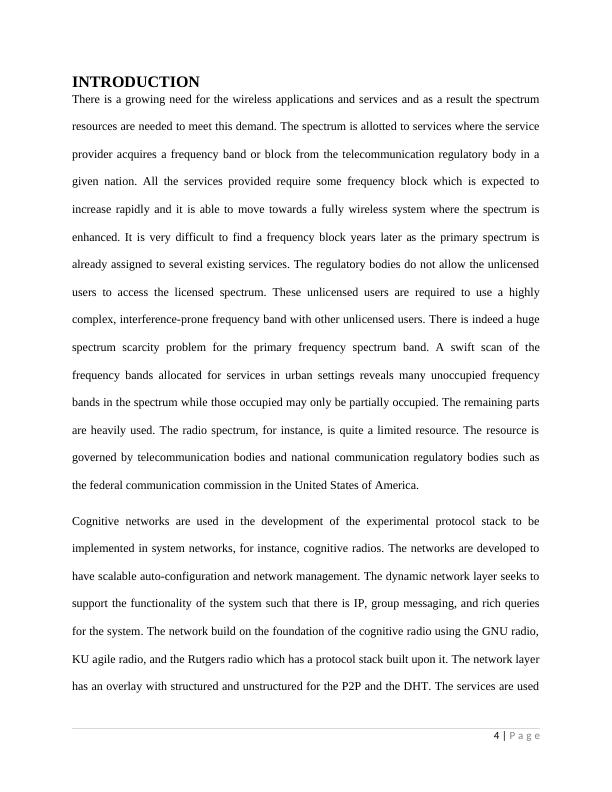
to map better and particular overlays. The overlay is used to determine the appropriate
application layer of the semi-persistent links between participating nodes that is used to forward
messages between the distributed application elements.
The current wireless communication systems are implemented in the telephony and interactive
internet data for the multimedia type of application. All communication systems desire improved
data rate during transmission and little or no interference. The frequency spectrum is a very
scarce resource that is allocated by telecommunication bodies to the different service providers.
These service providers are able to transmit information to the different mobile users using their
allocated frequency range in the spectrum with a guard band aimed at avoiding interference
between different channels. The technology used in cognitive radio networks presents a new
approach to the use of the scarce resource, that is, the frequency spectrum.
The concept is implemented in the wireless communication networks to ensure that the available
radio spectrum is used comprehensively and that the frequencies can be re-used in different cells
on the mobile communication networks. The cognitive radio technology opens several frontiers
that can be explored to develop better and more efficient wireless communication systems for
wireless and mobile computing. The systems end up forming the cognitive radio networks in the
cellular mobile communication networks by extending the radio link features and attributes to a
given network layer function. The system classifies the CRN architecture into a number of
unidirectional links and structures. This paper seeks to carry out an analysis on the MATLAB
software for the cognitive network and the performance analysis of the spectrum-reuse. Common
networks introduce issues for the protocol design, power efficiency, spectrum management and
detection, for the emotional awareness and improved algorithm design.
The system provides a solution to the crowding problem that results when too many service
5 | P a g e
application layer of the semi-persistent links between participating nodes that is used to forward
messages between the distributed application elements.
The current wireless communication systems are implemented in the telephony and interactive
internet data for the multimedia type of application. All communication systems desire improved
data rate during transmission and little or no interference. The frequency spectrum is a very
scarce resource that is allocated by telecommunication bodies to the different service providers.
These service providers are able to transmit information to the different mobile users using their
allocated frequency range in the spectrum with a guard band aimed at avoiding interference
between different channels. The technology used in cognitive radio networks presents a new
approach to the use of the scarce resource, that is, the frequency spectrum.
The concept is implemented in the wireless communication networks to ensure that the available
radio spectrum is used comprehensively and that the frequencies can be re-used in different cells
on the mobile communication networks. The cognitive radio technology opens several frontiers
that can be explored to develop better and more efficient wireless communication systems for
wireless and mobile computing. The systems end up forming the cognitive radio networks in the
cellular mobile communication networks by extending the radio link features and attributes to a
given network layer function. The system classifies the CRN architecture into a number of
unidirectional links and structures. This paper seeks to carry out an analysis on the MATLAB
software for the cognitive network and the performance analysis of the spectrum-reuse. Common
networks introduce issues for the protocol design, power efficiency, spectrum management and
detection, for the emotional awareness and improved algorithm design.
The system provides a solution to the crowding problem that results when too many service
5 | P a g e
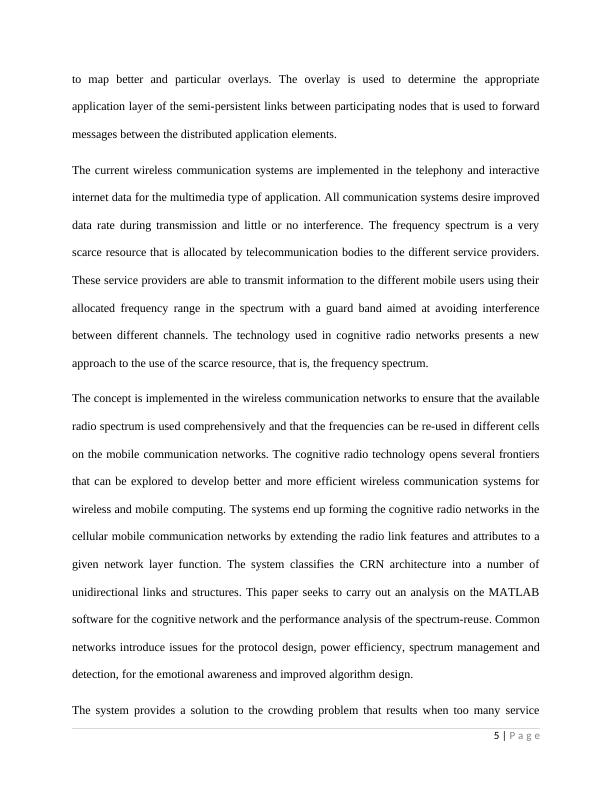
providers have purchased the frequency bands and the remaining bands are limited. The
cognitive radio networks perform the cognitive operations such as the sensing of the spectrum to
determine unused sections of the spectrum. The analysis seeks to determine interference spots,
noise temperature in the transmission network, radio channel characteristics, and the availability
of power in the spectrum. The mobile communication field has encountered advancements in
technology by adopting intelligent systems to have features such as smart antennae, cognitive
packets, smart radios, smart packets, and ultimately cognitive networks. The cognitive networks
employ a wide knowledge base to ensure that the networking technology is addressed using the
common aspect of the technology implemented. The cognitive radio is analysed as the most
preferred cognitive network within the system level scope of mobile communication. The
network intelligence ensures that the resources implemented are understood from a user
requirement point of view and the resources are only allocated to meet these requirements. The
model seeks to improve performance in the networks as well as ensure quality services. The
paper seeks to define the spectrum sensing techniques employed in the efficient implementation
of the fixed frequency spectrum allocation for the wireless communication networks while
utilizing the unused channels or frequency blocks in the network.
LITERATURE REVIEW
Cognitive radio networks
The cognitive network for the radio spectrum is a novel technology that seeks to improve the
spectrum utilization. It allows another user to borrow the unused portion of the frequency band in
6 | P a g e
cognitive radio networks perform the cognitive operations such as the sensing of the spectrum to
determine unused sections of the spectrum. The analysis seeks to determine interference spots,
noise temperature in the transmission network, radio channel characteristics, and the availability
of power in the spectrum. The mobile communication field has encountered advancements in
technology by adopting intelligent systems to have features such as smart antennae, cognitive
packets, smart radios, smart packets, and ultimately cognitive networks. The cognitive networks
employ a wide knowledge base to ensure that the networking technology is addressed using the
common aspect of the technology implemented. The cognitive radio is analysed as the most
preferred cognitive network within the system level scope of mobile communication. The
network intelligence ensures that the resources implemented are understood from a user
requirement point of view and the resources are only allocated to meet these requirements. The
model seeks to improve performance in the networks as well as ensure quality services. The
paper seeks to define the spectrum sensing techniques employed in the efficient implementation
of the fixed frequency spectrum allocation for the wireless communication networks while
utilizing the unused channels or frequency blocks in the network.
LITERATURE REVIEW
Cognitive radio networks
The cognitive network for the radio spectrum is a novel technology that seeks to improve the
spectrum utilization. It allows another user to borrow the unused portion of the frequency band in
6 | P a g e
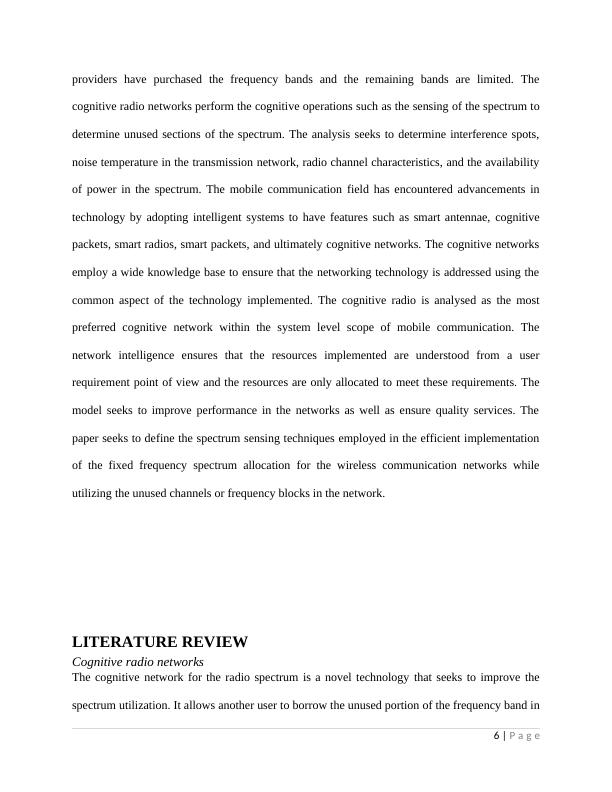
End of preview
Want to access all the pages? Upload your documents or become a member.
Related Documents
Spectrum Sensing Techniques and Cognitive Radiolg...
|48
|9271
|314
Spectrum Allocationlg...
|6
|2302
|78
Wireless Network Conceptslg...
|18
|2132
|232
Cyber-Physical Systemslg...
|8
|2449
|358
Optical 5G Fronthaul (Microwave Photonic)lg...
|9
|2048
|57
Cognitive Radio.lg...
|6
|4558
|3
